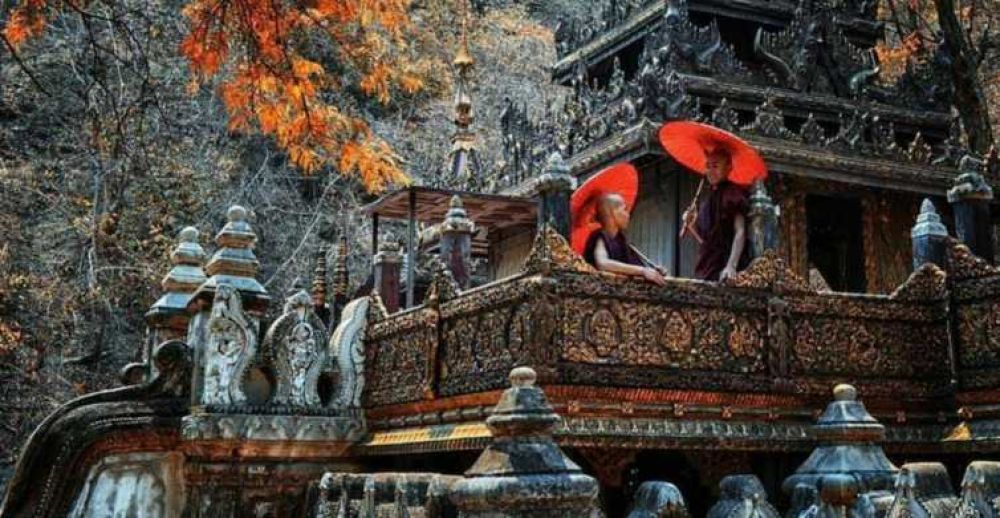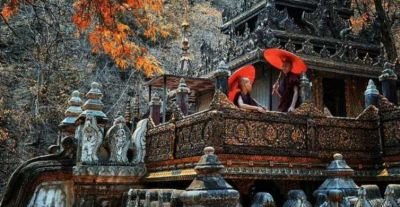

The Shwenandaw Monastery, also known as the Golden Palace Monastery due to its original use within the Mandalay Palace, is a stunning example of 19th-century Burmese teak architecture and intricate woodcarving. Visitors can embark on a guided historical tour to learn about the history of this significant site, where King Mindon died and which was later moved to its current location by his son, King Thibaw. The tour usually includes a detailed account of the monastery's religious significance, its architecture, and the process of conservation. Participants will have the chance to admire the impressive ornate carvings of Buddhist myths, which cover the walls and roofs of the monastery. The tour provides an in-depth understanding of Burmese culture and art.
Photography enthusiasts can take part in a photography walk around Shwenandaw Monastery, capturing the beauty of its golden teak structures and the morning light as it filters through the intricate woodcarvings. The monastery offers a picturesque setting with its detailed craftsmanship, which is even more enchanting during the soft light of the early morning or late afternoon. Participants will have plenty of time to take carefully composed shots of the monastery's exteriors, its atmospheric halls, and the surrounding gardens. With the expertise of a photography guide, visitors will learn how to take advantage of the light and shadow to create dramatic and memorable images of one of Myanmar's most celebrated religious sites.
Shwenandaw Monastery provides a tranquil setting for a meditation and mindfulness session, where visitors can immerse themselves in the serenity of this sacred space. Led by a knowledgeable instructor, the session is designed to teach participants the basics of Burmese meditation techniques in the Theravada Buddhist tradition. Surrounded by the monastery's spiritual ambiance, attendees will have the opportunity to practice mindfulness and explore the peaceful teachings of Buddhism. The course includes an introduction to meditation postures, breathing exercises, and guided meditations that aim to foster relaxation and introspection. This experience allows visitors to connect with the cultural heritage of Myanmar while finding personal peace.
At Shwenandaw Monastery, renowned for its impressive woodcarvings, visitors can participate in a hands-on woodcarving workshop. The class is led by a skilled artisan who teaches the traditional techniques used to create the elaborate designs seen around the monastery. During the workshop, participants will learn about the different types of wood used, the tools of the trade, and the cultural significance behind various motifs. All skill levels are welcome to join, and attendees will have the chance to carve their own simple pattern or motif under the guidance of the master woodcarver. This immersive activity provides a meaningful connection to the artistic heritage of the monastery, and each participant will leave with their own piece of handcrafted artwork as a souvenir.
Shwenandaw Monastery is a breathtaking location for sunset viewing. Visitors can witness the golden hues of the setting sun as it casts a warm glow over the intricate wooden carvings and multi-tiered roofs. This peaceful experience allows travelers to appreciate the monastery's stunning architecture in a different light. The activity includes access to select areas of the monastery which offer the best views of the sunset. Guests are encouraged to arrive early to find the perfect spot and can relax in the quiet contemplation of the day’s end. This is a popular activity for those looking to enjoy a tranquil moment and is often considered a highlight of a visit to Mandalay.
In the evenings, Shwenandaw Monastery occasionally hosts cultural performances that showcase the rich traditions of Burmese music, dance, and drama. These performances are held in the open-air spaces within the monastery grounds, providing a historic backdrop to the artistry on display. Audience members can expect to see traditional dances, colorful costumes, and hear the mesmerizing sounds of Burmese instruments. The experience is not only entertaining but also offers insight into the stories and legends that are woven into the fabric of Myanmar's cultural history. Special performances might include puppetry or enactments of scenes from the Jataka Tales (stories of Buddha's past lives).
Myanmar's tea culture is diverse and unique, and visitors to Shwenandaw Monastery can indulge in a traditional tea tasting experience. This activity features a range of locally sourced teas, each with its own flavor profile and history. A tea expert will guide participants through the tasting, explaining the processes of tea cultivation and preparation that are traditional to Myanmar. Guests will learn the correct way to brew and taste tea and explore the social importance of tea in Burmese society. The experience is relaxing and educational, set against the peaceful backdrop of the monastery's traditional environment.
Shwenandaw Monastery is not only a historical treasure but also features serene gardens and greenery. Visitors can take part in a nature walk around the monastery grounds, which will lead them through the various trees and plants that are native to the region. During this leisurely stroll, a guide will provide information about the local flora and the ecological significance of the site. The surroundings of the monastery are a haven for birdwatching and spotting other small wildlife. This is an excellent way to combine an appreciation of natural beauty with the exploration of one of Myanmar's most iconic religious landmarks.
For those interested in the religious practices of Myanmar, Shwenandaw Monastery offers classes on Buddhist rituals and traditions. These sessions can include learning about the daily lives of monks, Buddhist teachings, and the significance of various rituals performed within the monastery. An experienced monk or lay teacher often leads the class through discussions and demonstrations, giving participants a comprehensive overview of the role Buddhism plays in the lives of the Burmese people. Attendees may have the opportunity to join in chanting or observe a traditional alms-giving ceremony as part of the class.
The area around Shwenandaw Monastery is home to a number of local artisans and craftsmen who specialize in traditional Burmese arts and crafts. Visitors have the opportunity to embark on a tour that includes visits to nearby workshops and homes where these craftsmen create their goods. This may include lacquerware, tapestry, or silversmithing. Participants will get to see firsthand the talent and skill involved in the creation of these items, as well as the chance to speak with the artisans about their techniques and the history behind their craft. It's a fascinating glimpse into the local economy and culture and offers a chance to purchase unique souvenirs directly from the makers.
